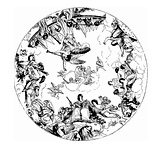
The Cloud of Witnesses Speaks
ACTION, CONTEMPLATION, MARTYDOM
What distinguishes the transitive and intransitive dimensions of action? For Aristotle and Aquinas, any action comes about along the metaphysical trajectory of potency and act. This dynamic suggests a venerable corollary: agere sequitur esse — “action follows on being.” But human action is distinctive. Conscious of our agency, we experience ourselves as present in our actions, yet not “fused” with them. Reflecting on the range of action, Aristotle says that “in general, motion is in the thing being moved,” and offers as examples building a house or weaving a garment. Both are transitive in character. But, of course, there are cases in which an act does not produce something external to the agent. These are intransitive in character. In such cases, he notes, “activity is present in these, as the act of seeing is in the one seeing, and the act of speculating in the one speculating, and life in the soul.” Nota bene: If we seek a happy life, we ought to look to the soul, since “happiness is in the soul [which] is a kind of life.”
Commenting on such activity, immanent rather than productive, St. Thomas writes that “the actuality then exists in the agent as its perfection,” so that “the act of seeing is in the one seeing as his perfection,” and, indeed, the activity of life is in the soul. The distinction between transitive and intransitive is, for Thomas, of pivotal importance, and he appeals to this distinction to help explain the nature of happiness: “Just as life is in one who lives, in a similar fashion happiness is in one who is happy,” from which it follows that happiness is not a matter of external production; rather, it “consists in understanding and willing.”
Jacques Maritain deftly profiles the two dimensions of action. The transitive brings movement to its object. Insofar as it transforms the material, this movement is visible; as such, it has temporal as well as spatial limits. The transitive also discloses the agent’s need; because of this need, the transitive directs the agent toward some object or other. By contrast, the intransitive draws the world inward, within the agent, and thus perfects the agent. “The soul, when it knows,” Maritain writes, “becomes thereby something that it is not, and when it loves, it aspires toward what it is not, as to another self.” Like the soul, this immanent activity endures. It serves as the ground of both the moral life and the contemplative life.
But what is it to live the contemplative life, as that life is embedded in the intransitive dimension of action? Aristotle tells us that it is to live the best of lives. And who is able to live such a life? Surely, he insists, neither the slave nor the artisan; surely neither the soldier nor the grasping politician. No, for it is the activity of understanding that characterizes the best of lives and enjoys something of the divine. But slaves and artisans, politicians and soldiers? Either they cannot or will not enjoy the leisure that invites understanding. Even should there emerge a ruler superior in virtue, he must redirect his life to the contemplation that is virtue’s crown. Contemplation, then, is for the few. But now a further pair of questions arises: What is it that these few are to contemplate, and how are they to do so? Skeptics might well suppose that even these few will find nothing more to contemplate than the very questions of what and how to contemplate. Is there anything more?
You May Also Enjoy
If one who contemplates shares in God's life, contemplation overflows in the free gift of self. Thus, indeed, it shows that it is of God.
When we move from the spiritual good of love to its material, concrete incarnation, we move into the realm of material goods that diminish by division.
The effort of the Church to come to terms with the modern world too often assumes that contemporary culture is neutral when, in fact, it is closed to the transcendent.

